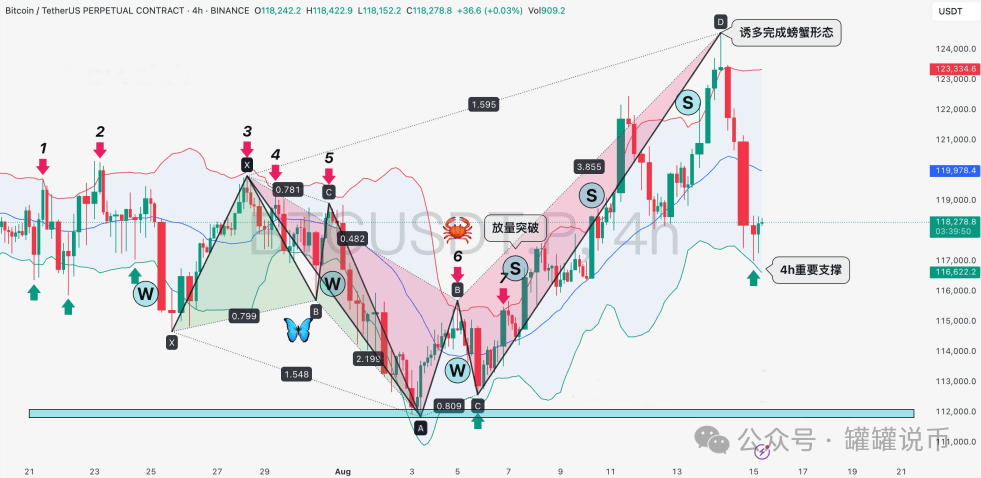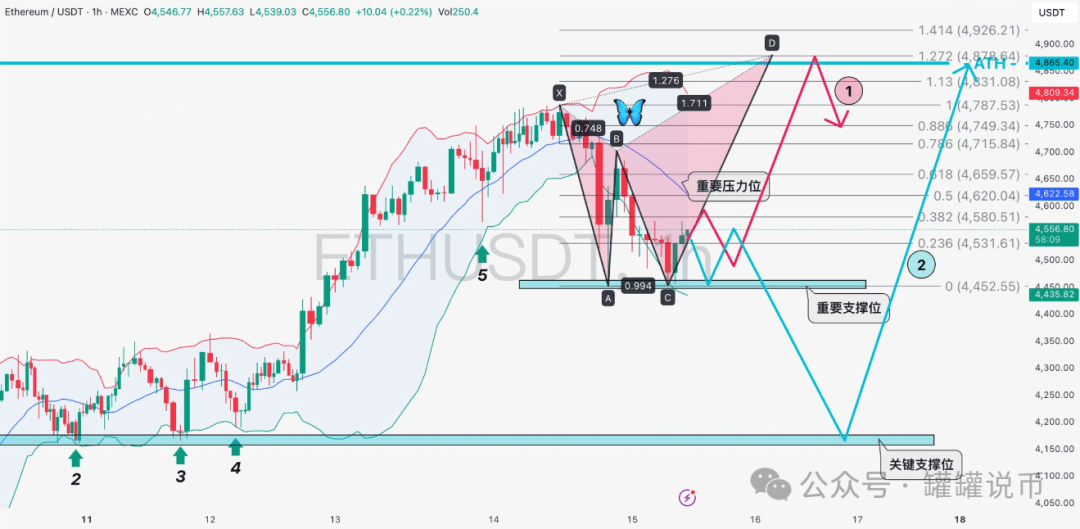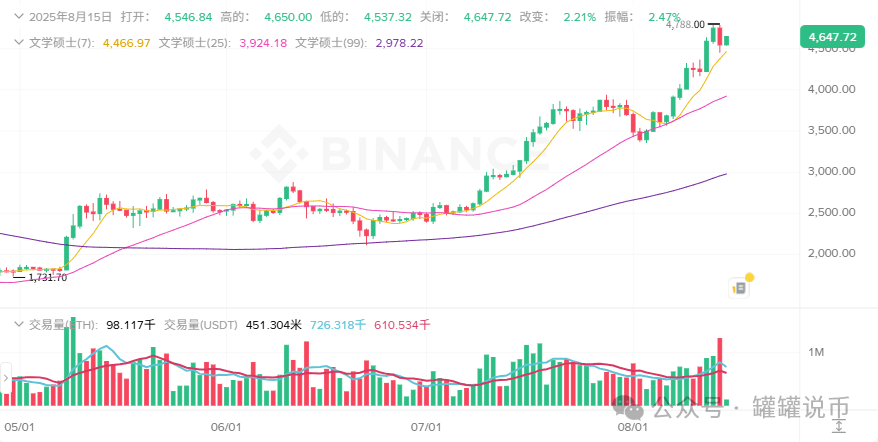Affected by the bearish PPI, Bitcoin's price dropped from $124,500 by more than $7,000, reaching a low of $117,180. Currently, it is in a rebound after being oversold, while Ethereum fell more than $200 from $4788, reaching a low of $4451. Currently, ETH is fluctuating around $4600. In the last 24 hours, a total of 221,517 people were liquidated globally, with a total liquidation amount of $1.018 billion.

Reason for last night's crash
1. The PPI data exceeded expectations, leading to a reduced probability of interest rate cuts in September.
2. The number of unemployment claims in the US for the week was lower than expected, leaning towards bearish.
3. US stocks opened lower, causing the crypto market to decline as well.
4. The net outflow of US spot ETFs was $293 million, ending six consecutive days of net inflow.
5. After Bitcoin reached a historical new high, profit-takers liquidated their positions, causing a market crash.
BTC
Bitcoin (BTC) broke through the upper Bollinger Band on the 4-hour chart after being suppressed for 7 consecutive times, signaling a strong SOS and successfully completing a standard crab pattern (theoretical target 1.618, actually reaching 1.595), setting a new historical high (ATH). Last night, influenced by the bearish PPI news, the market experienced a crash after a wave of induced buying, with prices quickly dipping to the key support level on the 4-hour chart. If the support level holds, a small rebound is expected; if it breaks, the next key support may align with the $112,000 area.

Currently, Bitcoin is in a phase of rebound from overselling. The current price increase should be viewed more as a short-term rebound rather than a true upward trend, and investors should pay attention to taking profits. The $120,000 resistance is significant, and it may be difficult to stabilize above it in the short term. If the market strengthens slightly, it may face resistance and retreat after touching $120,600. The main resistance levels above are $119,800 and $121,600. The ideal buying range is between $116,188 and $115,188. It is recommended to place orders in advance. Even if this range is not reached, there is no need to worry too much.
ETH
ETH dropped below the important 1-hour support last night, causing the overall market to break down and trigger liquidations. After the needle, the two supports around $4450 became particularly critical. There are two possible scenarios for the upcoming trend:
Red scenario: After breaking the midpoint resistance level on the 1-hour chart, ETH may directly impact the historical high (ATH), which is also the target of the butterfly pattern.
Blue scenario: ETH forms a descending continuation channel in the $4450 to $4600 range. If it breaks down from this range, it may continue to test the key support level around $4200.

Which scenario do you all prefer? Personally, I lean towards scenario 1, considering trying a long position with a stop loss to impact the market. Remember to have proper protection. If ETH breaks the blue line, it may experience a V-shaped rebound, and subsequently, pay attention to the resistance levels of 4666/4688, 4712, and 4770.
Although the 8-hour MACD shows a death cross, it is still far from the zero line, leaving room for variability. During the day, the 4-hour MACD might issue a stop-loss signal, making it unlikely to return to the low point of 4412 from the 8-hour adjustment.

Many people are still asking if there will be another big drop?
Uniform response: Add to positions, otherwise it would be a waste of the needle. After the needle, the 15, 30-minute, and 1-hour levels will see a rebound. When the 4-hour MACD signals a stop-loss, it will move in a V shape to recover all declines.
Altcoin
The sharp decline of Bitcoin and Ethereum last night also dragged down the altcoin market, and mainstream altcoins with declines exceeding 4-6% can be considered for spot buying. Such opportunities are rare because when the market continuously rises and approaches high levels, people are less willing to increase their positions. Today is mainly about repairing indicators below the 1-hour level, reorganizing forces, and preparing to strike again.
In the altcoin market, as previously mentioned, it is still an ETH-dominated market. Although Bitcoin and BNB have reached new highs first, the altcoins that have seen significant increases are still mostly ETH-related, such as $GTC, $SKL, $EIGEN, $ARB, $ZK, etc. The performance of sectors like infrastructure, DeFi, and L2 is quite strong.
However, these projects are relatively weak compared to ETH itself. For example, $ARB still has about a 50% decline that hasn't been recovered. I have a cautious attitude towards the future trends of such altcoins, as they may fall further behind ETH.
According to my investment strategy, I will allocate a maximum of 10% of my position to such altcoins, with this round mainly focusing on heavy positions in leading coins. If the expected returns on leading coins are unsatisfactory, one might consider turning to crypto stocks. Crypto stocks have higher volatility, which may bring higher Alpha returns, while being more able to avoid liquidation risks compared to contract trading. Overall, the risk control of crypto stocks is more prudent than that of contracts.